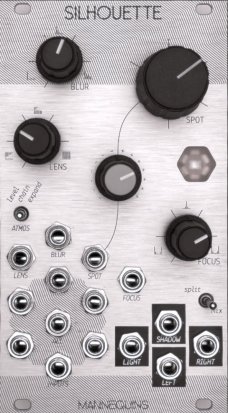Whimsical Raps Silhouette arrived yesterday while I was at work, and I spent about 90 minutes playing with it. And then about 3 hours this morning while waiting for stuff to finish building at work.

The module consists of:
- an input crossfader/selector (the big Spot knob) that scans through 6 inputs, and outputs them on the Light output. The LED display below Spot shows the actual position. The selected signal goes to the Light output (unaffected by any other controls)
- The little grey knob, if you don’t patch anything to its input, is a built-in modulation source with a sort of “pause” in it. Unfortunately, it has a minimum speed faster than one might like, so you’ll have to patch an external source into the Spot CV input to go more slowly. And then you have to use a ramp at exactly the expected voltage range if you want it to travel in a continuous circle.
- The All input goes into any unpatched inputs, but with alternating polarity. So as you sweep through Spot, the signal is cancelled and un-cancelled.
- the selected signal also goes through a filtered BBD (controlled by the Focus knob) to the Shadow output. There’s no built-in feedback, you’re expected to patch that if you want it.
- The Left/Right outputs also optionally include a reverb (the Blur knob).
- With the output switch at Split, Spot rotates inputs around the stereo field in a circular manner, and silences them when it points directly at that input. The delayed signal isn’t present on the L/R inputs in this mode (without feedback patching).
- With output set to Mix, it *also* mixes the Light and Shadow signals directly into the output — which covers that silent gap in the circle.
- The Atmos switch controls different VCA behavior:
– Level: the reverb is always present, and Lens controls the main signal level
– Chain: dry and reverbed signals are sidechained by other input signals (affected by Spot)
– Expand: the reverbed signal is ducked by the dry signal - All of this works with CV signals too, not just audio. So you can mix and distribute different modulation sources, and even (if you’re a bit crazy) affect them with delay/reverb.
The implications of all this are… quite a lot. You can use it for some basic mixing or an end-of-chain effect, or get very weird with feedback patches and make surprising sounds with only a couple of other modules (or just by itself really).
This is replacing Bunker Archeology in my case and I will have absolutely no regrets. In fact the kind of stuttering and reverb that BA did? This can also do that. Not exactly the same way of course, but still.
